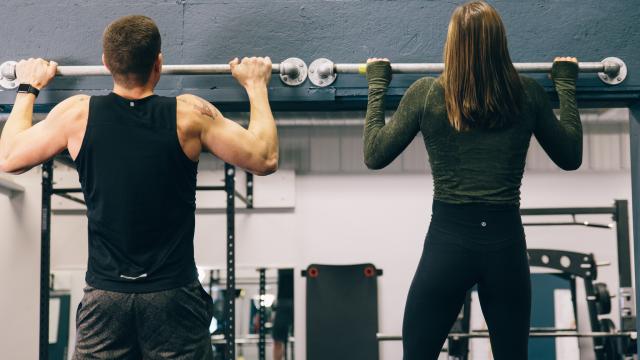The journey from zero pull-ups to one pull-up is long, difficult, and may at times seem insurmountable. And then once you get there, victory is fleeting: Every set you attempt contains one measly rep. Either way, you’re going to need some ways to bring that lofty exercise down to earth.
Photo by ThoroughlyReviewed.
The exercises on this list are easier than a strict pull-up, but they work some or all of the same muscles. Pick something that feels challenging but doable, and even if you don’t make it to full pull-ups by the end of the month, you’ll at least be closer.
We’ll put these in a rough order from easiest to hardest, but feel free to hop around the list depending on what feels most appropriate to you.
- Assisted pull-ups with a machine such as the Gravitron (above) that takes off as much weight as you like.
- Lat pulldowns, another gym machine. This is the same motion as a pull-up, but you’re seated so it’s more about arms and less about your core and everything else. You can also adjust the weight on these.
- Inverted rows, an exercise you can do on a lower height bar. Set the bar of the smith machine to whatever height you like, or do these on a suspension trainer.
- Assisted pull-ups with a resistance band. You need to hang one of those big elastic bands from the bar so that you can put one foot or knee in it, and then the band helps give you a boost as you pull up.
- Box pull-ups are simple to set up if you have a doorway bar: Just set a chair in the doorway, and put one foot on it while you do your pull-ups. Push with your foot as much as you need to. In a gym, rather than a dining room chair, you can use a box or whatever seems appropriate (and safe).
- Negative reps build strength fast. Jump or climb to the top of the pull-up position, and then slowly lower yourself down.
- Flexed arm hangs involve hanging from the pull-up bar at the top position, without trying to move up and down. They work some of the same muscles, and you can measure progress by how long you can hang.
- Scap pull-ups (above) work the bottom of the pull-up motion. Start at a dead hang, and then imagine that you’re pushing the bar down toward your waist with straight arms. This activates your back and shoulder muscles. (The “scap” in the name refers to your scapula, that big shoulder blade bone on your back.)
- Chin-ups and neutral grip pull-ups are just variations on grip: In a chin-up, your palms face toward you instead of away. They allow more of your little forearm muscles to get in on the action, so they’re just a little bit easier.
Once you are a pull-up beast, don’t forget that you can use these same exercises, especially the assisted pull-ups, to practise more advanced moves such as one-armed pull-ups, pull-ups with just your fingers, or any other pull-up of your dreams.

Comments